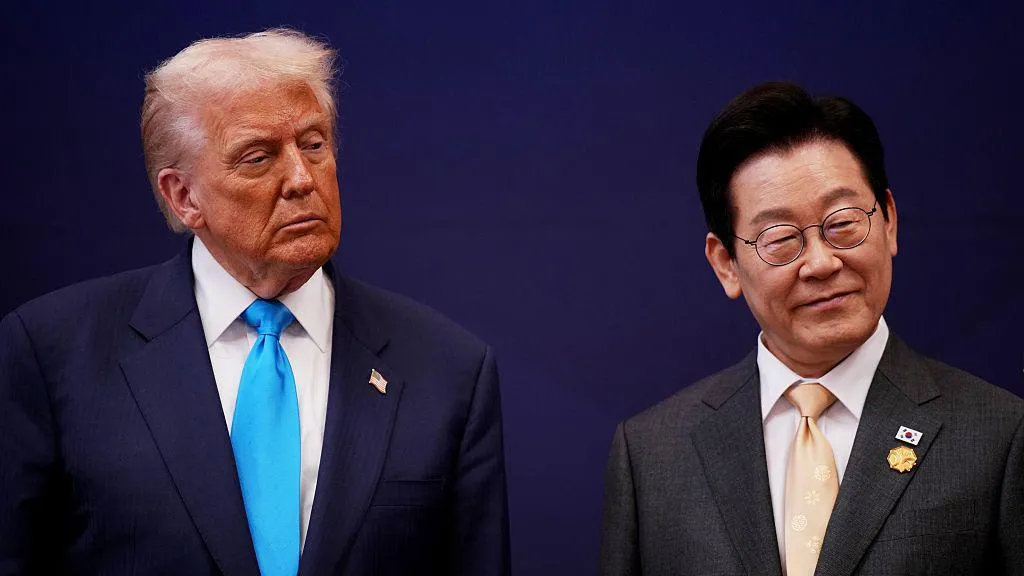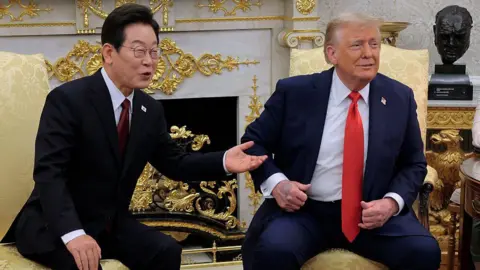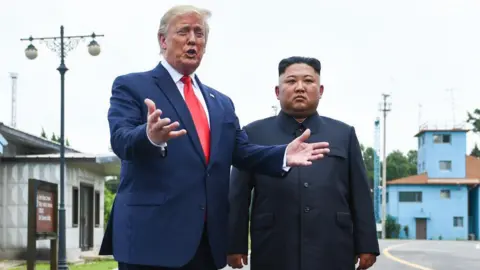
Ahead of Lee's White House visit, anxieties were bubbling in Seoul that the meeting could turn bitter.
Hours before South Korean president Lee Jae Myung was due to meet US president Donald Trump, a Truth Social post dropped.
"WHAT IS GOING ON IN SOUTH KOREA?" Trump wrote, pointing to a "Purge or Revolution". It appears this was a reference to Mr Lee's attempts to move South Korea on from its martial law crisis last December, when its now ousted President Yoon Suk Yeol tried to orchestrate a military takeover.
But Lee turned on the charm and averted a repeat of what happened in the Oval Office to Ukraine's Volodymyr Zelensky or South Africa's Cyril Ramaphosa.
The leaders found common ground on North Korea, with Trump repeatedly mentioning Kim Jong Un, and they managed to avoid public disagreements over thorny trade and defence issues. Here are three main takeaways.
Lee's strategy of flattery worked
Lee's team had been nervous about this meeting, and they had good reason to be: Trump is historically wary of South Korea, despite it being a US ally. In the past, he has accused it of freeloading from the tens of thousands of US troops that are stationed on the peninsula helping to defend against North Korea. He has also criticised Seoul's defence spending and its trade surplus with the US.
Lee, seen as a left-wing politician, has a reputation in Washington that plays to the worst of Trump's fears. In the past, he has been sceptical of South Korea's military alliance with the US, and now says wants to develop stronger ties with China. He has also been painted by some US conservative commentators as being "anti-American".
Lee's team had been worried he might be subjected to one of Trump's now famous Oval Office dressing downs.
The truth social post in the hours before the meeting gave them a scare. Trump's ominous-sounding message appeared to be referring to the aftermath of South Korea's martial law crisis last December, and the efforts Mr Lee's government and prosecutors are making to investigate the ousted president Yoon Suk Yeol, his wife, and former members of his government.
It is something the far-right in South Korea, and even some in the US, have railed against.
This was the nightmare scenario for South Korean officials – that Mr Lee might be forced to defend himself against right wing conspiracy theories. But when the meeting arrived, Mr Trump raised the issue, only to quickly brush it off as a probable misunderstanding.
Lee's strategy of flattery clearly worked. He first marveled at the Oval Office's "bright and beautiful" new look, then heaped praises the personal rapport that the US president has built with North Korean leader Kim Jong Un, asking him to help make peace between the North and South.
"The only person who can make progress is you Mr President", Mr Lee said. "If you become the peacemaker, then I will assist you by being a pacemaker."
Lee even joked about building a Trump Tower in North Korea and playing golf there.

If this seems a little fawning, this was South Korea's strategy for this high-stakes meeting, which was meant to cover trade, the role of US troops in South Korea and how much Seoul spends on its defence.
The number one goal of Lee's team was to make sure that he left the Oval Office on Trump's good side, having avoided a Zelensky moment, and they succeeded.

Kim Jong Un looms large
It might look strange to see President Trump sitting next to the South Korean leader, in their first ever meeting, talking about how well he gets on with Kim Jong Un, the South's sworn enemy, and how much he's looking forward to meeting him again.
But this is actually one of the few areas of common ground these two leaders have.
South Korea's relatively new president Lee Jae Myung is taking a new approach to North Korea than that of his predecessor, who was accused of antagonising Kim Jong Un.
It was, in fact, Lee who initiated the conversation about Kim Jong Un, praising President Trump for the personal rapport he has built with the North Korean leader, and asking him to act as a "peacemaker" on the Korean peninsula.
Lee wants to talk to Kim, to establish peaceful relations between the North and South, but he knows that Trump has a far better chance of making this happen than he does.
Trump, who met Kim three times in his first term, often brings up the dictator. He famously said the pair "fell in love" while exchanging letters, but they failed to reach a deal to limit North Korea's nuclear programme.
"I spent a lot of free time with him, talking about things that we probably aren't supposed to talk about," Trump said on Monday. "I get along with him really well. I look forward to meeting with Kim Jong Un in the appropriate future."
The question is whether Kim Jong Un will want to talk to either Trump or Lee.
North Korea has repeatedly rejected Lee's efforts to talk, and ignored attempts by the US to restart dialogue. It hasn't closed the door on talking to Trump, but has suggested it would have to be on different terms than before, because it will not under any circumstances give up its nuclear weapons.
This is now something Seoul and Washington must try to navigate.
Trade, defence issues largely unaddressed
The main purpose of Lee's White House visit was to discuss the two countries recent trade deal and the role of US troops in South Korea, but both leaders managed to avoid being drawn on the specifics of these contentious issues while in the Oval Office.
Seoul negotiated US tariffs on South Korean goods down to 15%, after Trump threatened rates as high as 25%. This came after it agreed to invest $350bn (£264.1bn) in the US - $150bn of which will go into helping the US build ships.
South Korea has a thriving shipbuilding industry, building more vessels than any other country in the world other than China, at a time when US shipbuilding and its navy are in decline. And just hours after Lee's White House meeting, Korean Airannounced that it would buy 103 Boeing planes.
The finer details and sticking points of the trade deal, including what happens to the profits from these investments, are being worked out by officials behind the scenes.
"I think we have a deal done" on trade, Trump told reporters after the meeting, without providing more details. "They had some problems with it, but we stuck to our guns," he said, noting the importance of the countries' economic partnership.
"The US and South Korea "need each other" for trade, Trump told reporters in Lee's presence. "We love what they do, we love their products, we love their ships, we love a lot of the things they make," he said. Meanwhile South Korea needs oil and gas, and the US would be trading those with them, he added.
In the Oval Office, Trump also sidestepped a question about withdrawing US troops from South Korea - an idea that the White House is reportedly toying with. He has in the past accused South Korea of taking advantage of US protection, by not spending enough on its defence.
Also on Monday, Trump floated the idea of letting the US own the piece of land housing Osan Air Base, to the south of Seoul, jointly operated by the US and South Korea.